Page 9 of 56
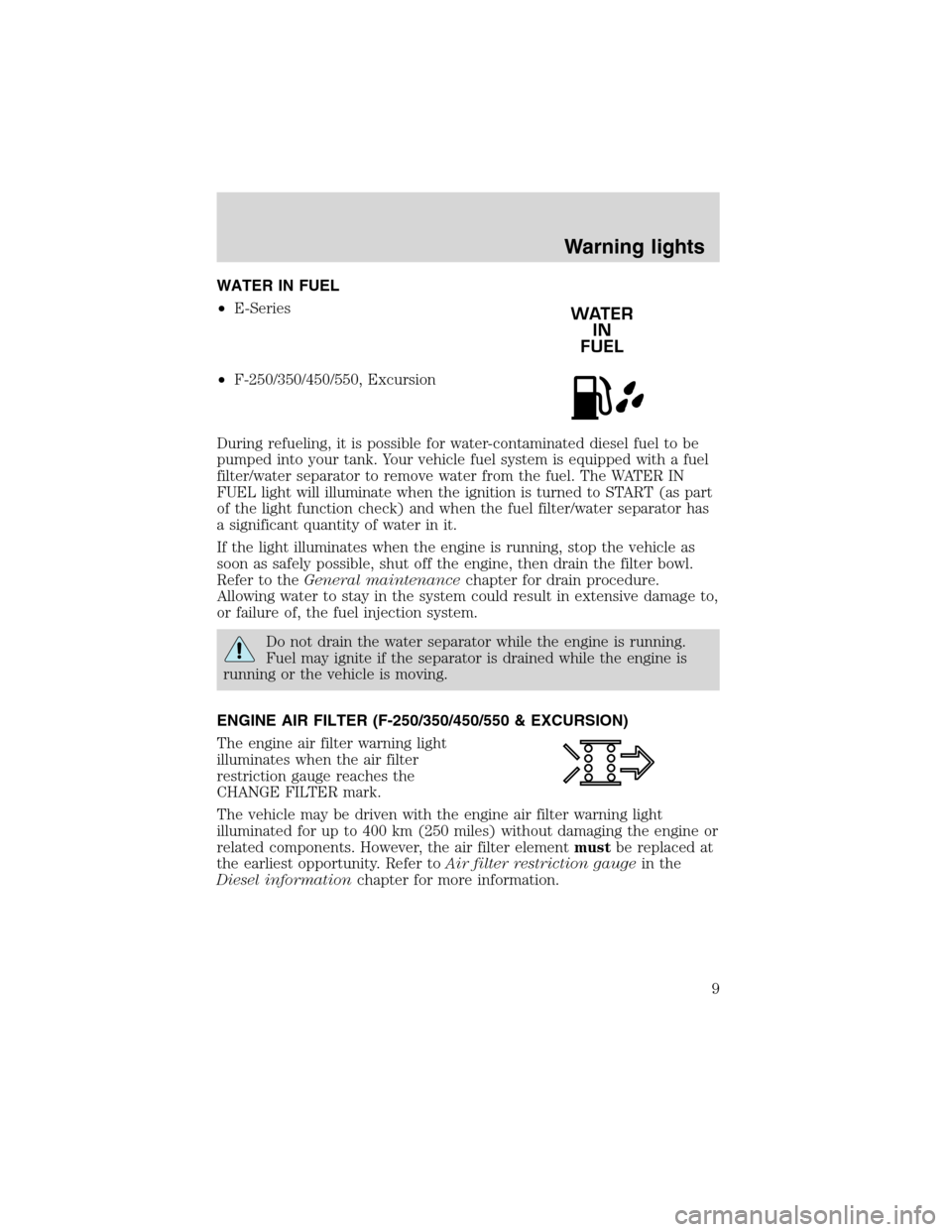
WATER IN FUEL
•E-Series
•F-250/350/450/550, Excursion
During refueling, it is possible for water-contaminated diesel fuel to be
pumped into your tank. Your vehicle fuel system is equipped with a fuel
filter/water separator to remove water from the fuel. The WATER IN
FUEL light will illuminate when the ignition is turned to START (as part
of the light function check) and when the fuel filter/water separator has
a significant quantity of water in it.
If the light illuminates when the engine is running, stop the vehicle as
soon as safely possible, shut off the engine, then drain the filter bowl.
Refer to theGeneral maintenancechapter for drain procedure.
Allowing water to stay in the system could result in extensive damage to,
or failure of, the fuel injection system.
Do not drain the water separator while the engine is running.
Fuel may ignite if the separator is drained while the engine is
running or the vehicle is moving.
ENGINE AIR FILTER (F-250/350/450/550 & EXCURSION)
The engine air filter warning light
illuminates when the air filter
restriction gauge reaches the
CHANGE FILTER mark.
The vehicle may be driven with the engine air filter warning light
illuminated for up to 400 km (250 miles) without damaging the engine or
related components. However, the air filter elementmustbe replaced at
the earliest opportunity. Refer toAir filter restriction gaugein the
Diesel informationchapter for more information.
Warning lights
9
Page 10 of 56
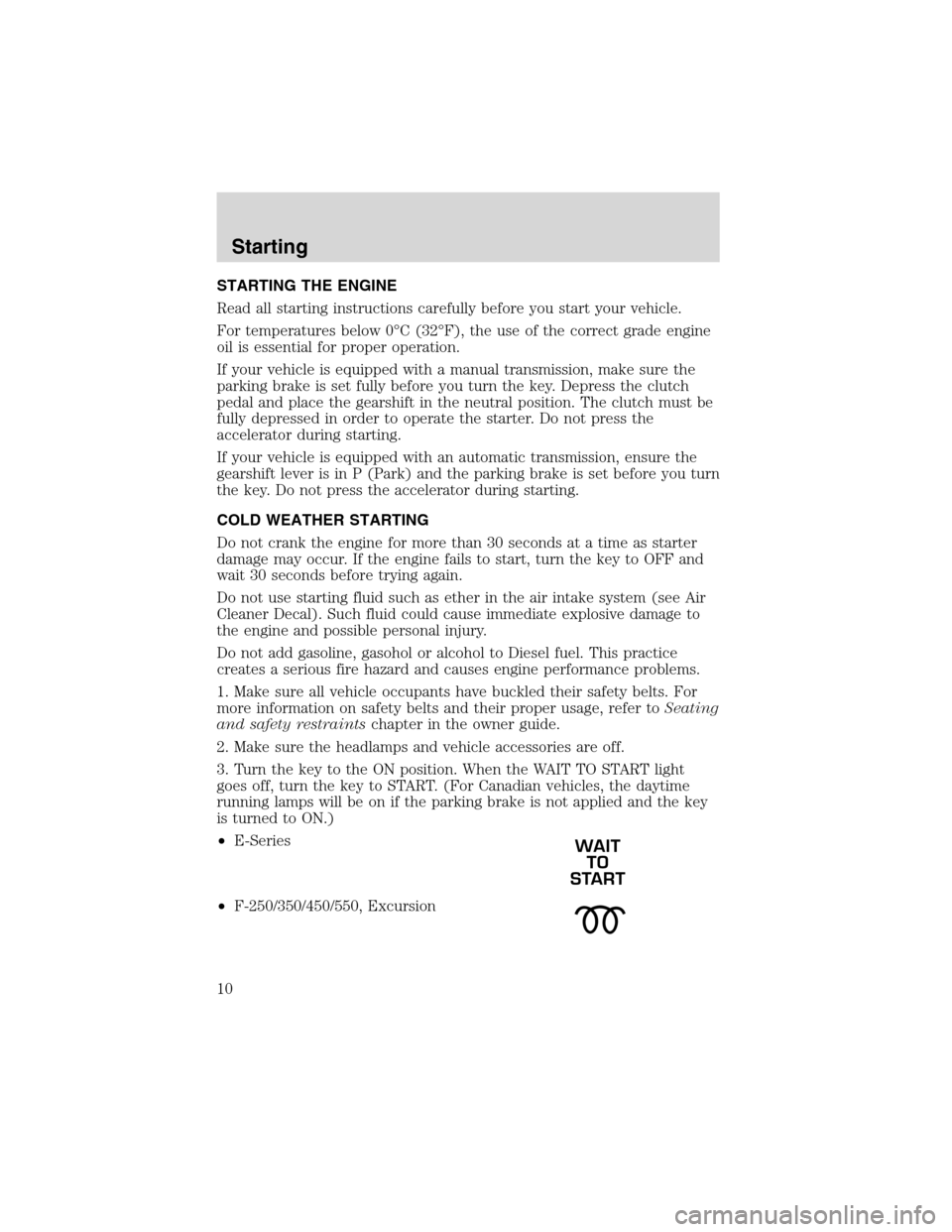
STARTING THE ENGINE
Read all starting instructions carefully before you start your vehicle.
For temperatures below 0°C (32°F), the use of the correct grade engine
oil is essential for proper operation.
If your vehicle is equipped with a manual transmission, make sure the
parking brake is set fully before you turn the key. Depress the clutch
pedal and place the gearshift in the neutral position. The clutch must be
fully depressed in order to operate the starter. Do not press the
accelerator during starting.
If your vehicle is equipped with an automatic transmission, ensure the
gearshift lever is in P (Park) and the parking brake is set before you turn
the key. Do not press the accelerator during starting.
COLD WEATHER STARTING
Do not crank the engine for more than 30 seconds at a time as starter
damage may occur. If the engine fails to start, turn the key to OFF and
wait 30 seconds before trying again.
Do not use starting fluid such as ether in the air intake system (see Air
Cleaner Decal). Such fluid could cause immediate explosive damage to
the engine and possible personal injury.
Do not add gasoline, gasohol or alcohol to Diesel fuel. This practice
creates a serious fire hazard and causes engine performance problems.
1. Make sure all vehicle occupants have buckled their safety belts. For
more information on safety belts and their proper usage, refer toSeating
and safety restraintschapter in the owner guide.
2. Make sure the headlamps and vehicle accessories are off.
3. Turn the key to the ON position. When the WAIT TO START light
goes off, turn the key to START. (For Canadian vehicles, the daytime
running lamps will be on if the parking brake is not applied and the key
is turned to ON.)
•E-Series
•F-250/350/450/550, Excursion
Starting
10
Page 11 of 56

4. When the engine starts, release the key. The glow plugs will continue
to be activated for up to two minutes. If the engine is not started before
the activation ceases, the glow plug system must be reset by turning the
ignition key to OFF.
5. After the engine starts, allow it to idle for about 15 seconds. (Do not
increase engine speed until the oil pressure gauge indicates normal
pressure.)
STOPPING THE ENGINE
Turn the ignition to OFF. To prolong engine life (after extended high
speed or maximum GVW operation), it is recommended that a hot engine
be allowed to operate at low idle for about 7–10 minutes which would
allow sufficient time for the turbocharged engine to cool down.
COLD WEATHER OPERATION
Changing to a lighter grade engine oil also makes starting easier under
these conditions. Refer toEngine Oil Specificationsin theGeneral
maintenance informationchapter.
At temperatures below–7°C (20°F), Number 2–D Diesel fuel may
thicken enough to clog the fuel filter. Your engine is equipped with a fuel
filter/heater/water/separator to keep the wax melted which will help
prevent fuel filter clogging. However, if the engine starts but stalls after a
short time and will not restart, the fuel filter may be clogged. For best
results in cold weather, use Number 1–D Diesel fuel or“winterized”
Number 2–D Diesel fuel which has an additive to minimize wax
formation.
Your vehicle is also equipped with a bypass relief valve, located on the
in-tank fuel sending unit, which provides fuel flow to the engine if the
fuel pickup should become plugged by ice or wax. To allow this bypass
valve to function and avoid engine fuel starvation, it is recommended
that, during cold weather operation 0°C (32°F) or below, the fuel level in
your tank should not be allowed to drop below 1/4 full. This will help
prevent air from entering the fuel system and stalling the engine.
In cold weather below 0°C (32°F) your Diesel engine will slowly increase
to a higher idle speed if left idling in P (Park). The sound of the engine
may change also, as an exhaust device engages to improve heater
performance and reduce exhaust smoke.
Starting
11
Page 12 of 56
Operation in snow
Vehicle operation in heavy snowfall or in dry loose snow that may swirl
around the front of the vehicle may feed excessive amounts of snow into
the air intake system. This could plug the air cleaner with snow and
cause the engine to stall.
Refer toAir filter restriction gaugein theDiesel informationchapter
and Engine air filter in theWarning lightschapter for more information.
Operation in standing water
Ingestion of water into the Diesel engine can result in immediate and
severe damage to the engine. If driving through water, slow down to
avoid splashing water into the intake. If the engine stalls, and ingestion
of water into the engine is suspected, do not try to restart the engine.
Consult your dealer for service immediately. Follow the cylinder
compression test procedure outlined in the Workshop Manual, then
check the engine oil for contamination.
Engine block heater (if equipped)
Refer to theStartingchapter in your Owner Guide.
Starting
12
Page 13 of 56
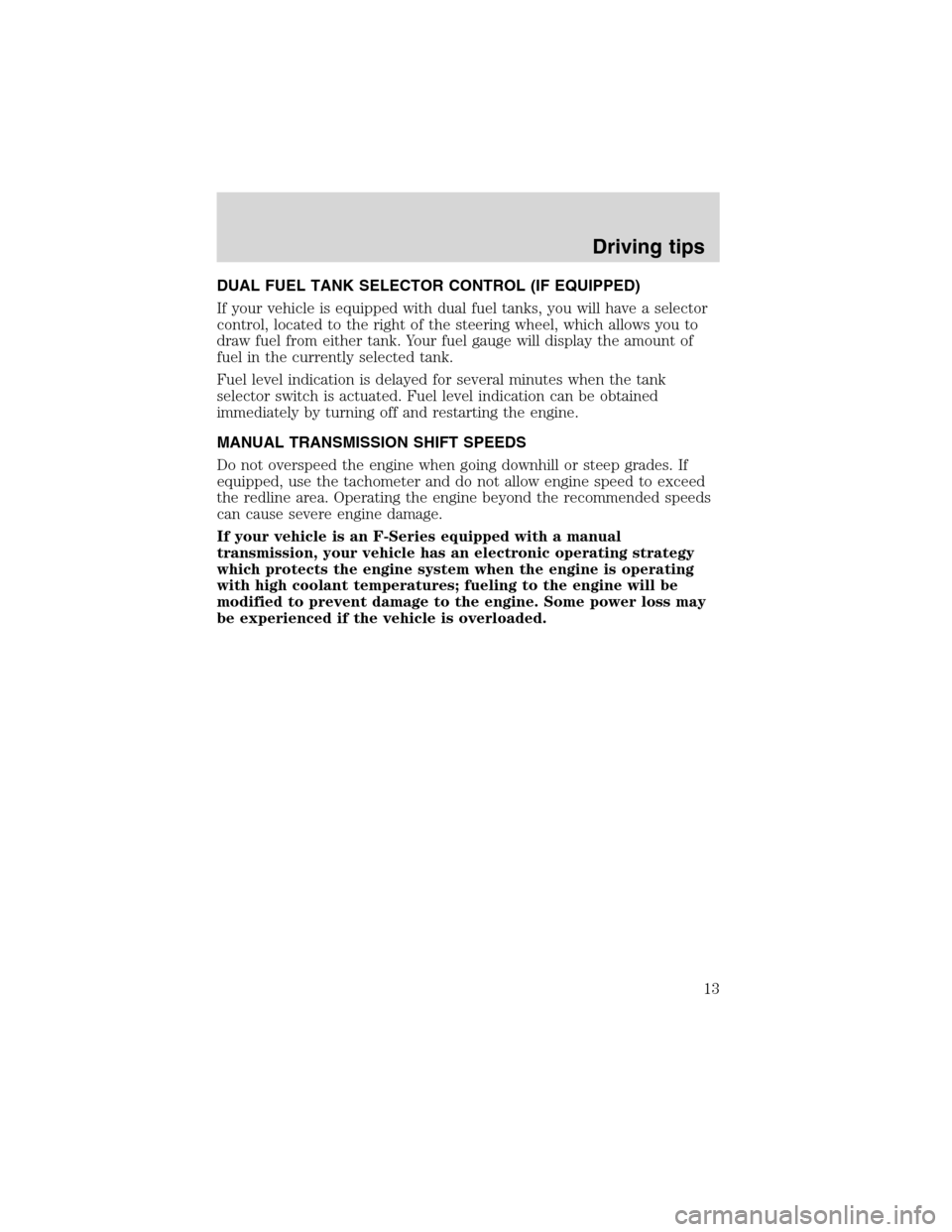
DUAL FUEL TANK SELECTOR CONTROL (IF EQUIPPED)
If your vehicle is equipped with dual fuel tanks, you will have a selector
control, located to the right of the steering wheel, which allows you to
draw fuel from either tank. Your fuel gauge will display the amount of
fuel in the currently selected tank.
Fuel level indication is delayed for several minutes when the tank
selector switch is actuated. Fuel level indication can be obtained
immediately by turning off and restarting the engine.
MANUAL TRANSMISSION SHIFT SPEEDS
Do not overspeed the engine when going downhill or steep grades. If
equipped, use the tachometer and do not allow engine speed to exceed
the redline area. Operating the engine beyond the recommended speeds
can cause severe engine damage.
If your vehicle is an F-Series equipped with a manual
transmission, your vehicle has an electronic operating strategy
which protects the engine system when the engine is operating
with high coolant temperatures; fueling to the engine will be
modified to prevent damage to the engine. Some power loss may
be experienced if the vehicle is overloaded.
Driving tips
13
Page 14 of 56
Upshift and downshift according to the following shift speed charts:
Upshifts when accelerating
(recommended for best fuel economy)
6-speed transmission
Shift from: Transfer case position
1(if equipped)
2H or 4H 4L
LO-1 8 km/h (5 mph) 3 km/h (2 mph)
1-2 16 km/h (10 mph) 6 km/h (4 mph)
2-3 32 km/h (20 mph) 13 km/h (8 mph)
3-4 48 km/h (30 mph) 19 km/h (12 mph)
4-
D(Overdrive)64 km/h (40 mph) 24 km/h (15 mph)
Maximum downshift speeds1
6-speed transmission
Shift from: Transfer case position (if equipped)2
2H or 4H 4L
D(Overdrive) - 472 km/h (45 mph) 26 km/h (16 mph)
4-3 56 km/h (35 mph) 19 km/h (12 mph)
3-2 32 km/h (20 mph) 13 km/h (8 mph)
2-1 8 km/h (5 mph) 3 km/h (2 mph)
1-LO Only shift to LO when at a stop.
1Use 2H or 4H for 4WD equipped vehicles.2Downshift at lower speeds when driving on slippery surfaces.
Driving tips
14
Page 15 of 56
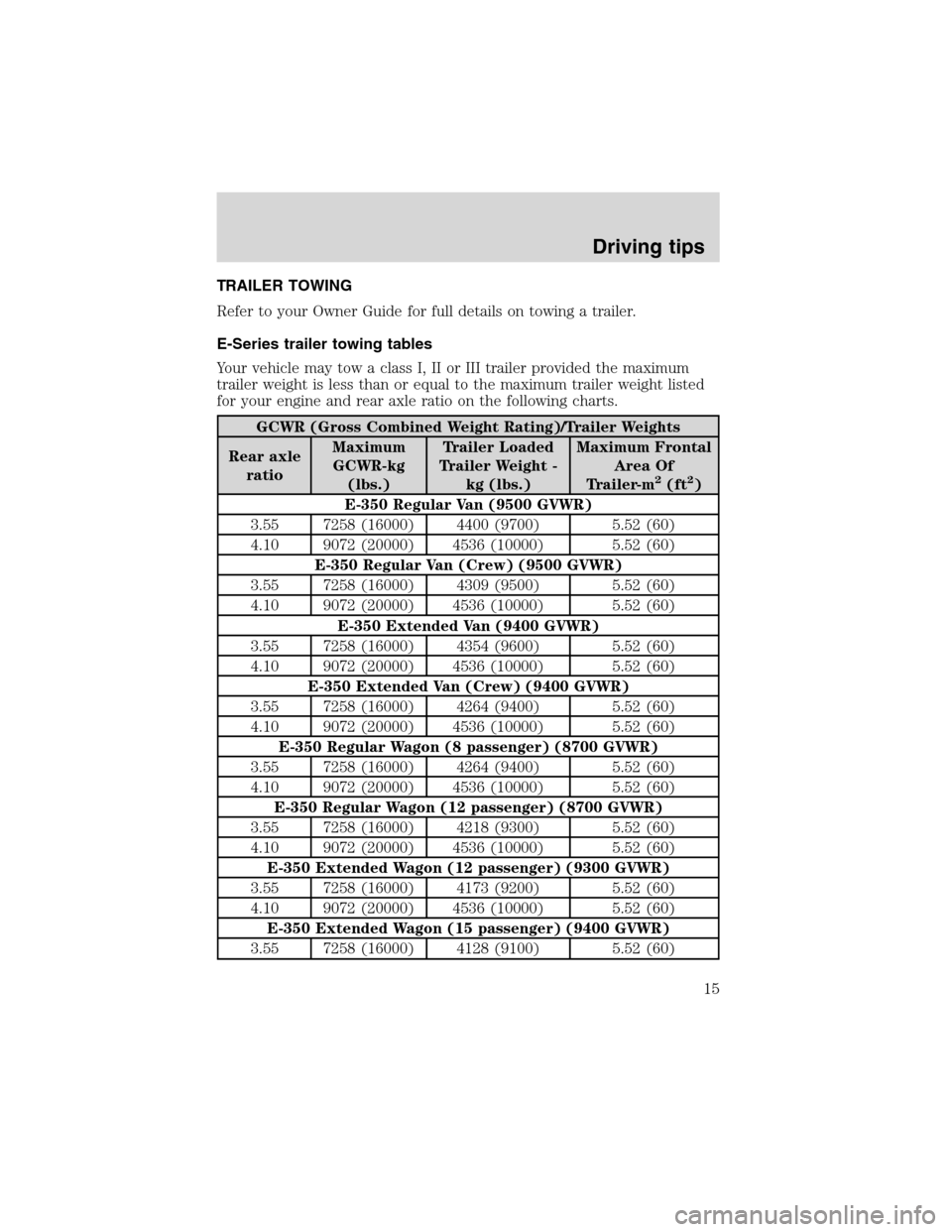
TRAILER TOWING
Refer to your Owner Guide for full details on towing a trailer.
E-Series trailer towing tables
Your vehicle may tow a class I, II or III trailer provided the maximum
trailer weight is less than or equal to the maximum trailer weight listed
for your engine and rear axle ratio on the following charts.
GCWR (Gross Combined Weight Rating)/Trailer Weights
Rear axle
ratioMaximum
GCWR-kg
(lbs.)Trailer Loaded
Trailer Weight -
kg (lbs.)Maximum Frontal
Area Of
Trailer-m
2(ft2)
E-350 Regular Van (9500 GVWR)
3.55 7258 (16000) 4400 (9700) 5.52 (60)
4.10 9072 (20000) 4536 (10000) 5.52 (60)
E-350 Regular Van (Crew) (9500 GVWR)
3.55 7258 (16000) 4309 (9500) 5.52 (60)
4.10 9072 (20000) 4536 (10000) 5.52 (60)
E-350 Extended Van (9400 GVWR)
3.55 7258 (16000) 4354 (9600) 5.52 (60)
4.10 9072 (20000) 4536 (10000) 5.52 (60)
E-350 Extended Van (Crew) (9400 GVWR)
3.55 7258 (16000) 4264 (9400) 5.52 (60)
4.10 9072 (20000) 4536 (10000) 5.52 (60)
E-350 Regular Wagon (8 passenger) (8700 GVWR)
3.55 7258 (16000) 4264 (9400) 5.52 (60)
4.10 9072 (20000) 4536 (10000) 5.52 (60)
E-350 Regular Wagon (12 passenger) (8700 GVWR)
3.55 7258 (16000) 4218 (9300) 5.52 (60)
4.10 9072 (20000) 4536 (10000) 5.52 (60)
E-350 Extended Wagon (12 passenger) (9300 GVWR)
3.55 7258 (16000) 4173 (9200) 5.52 (60)
4.10 9072 (20000) 4536 (10000) 5.52 (60)
E-350 Extended Wagon (15 passenger) (9400 GVWR)
3.55 7258 (16000) 4128 (9100) 5.52 (60)
Driving tips
15
Page 16 of 56
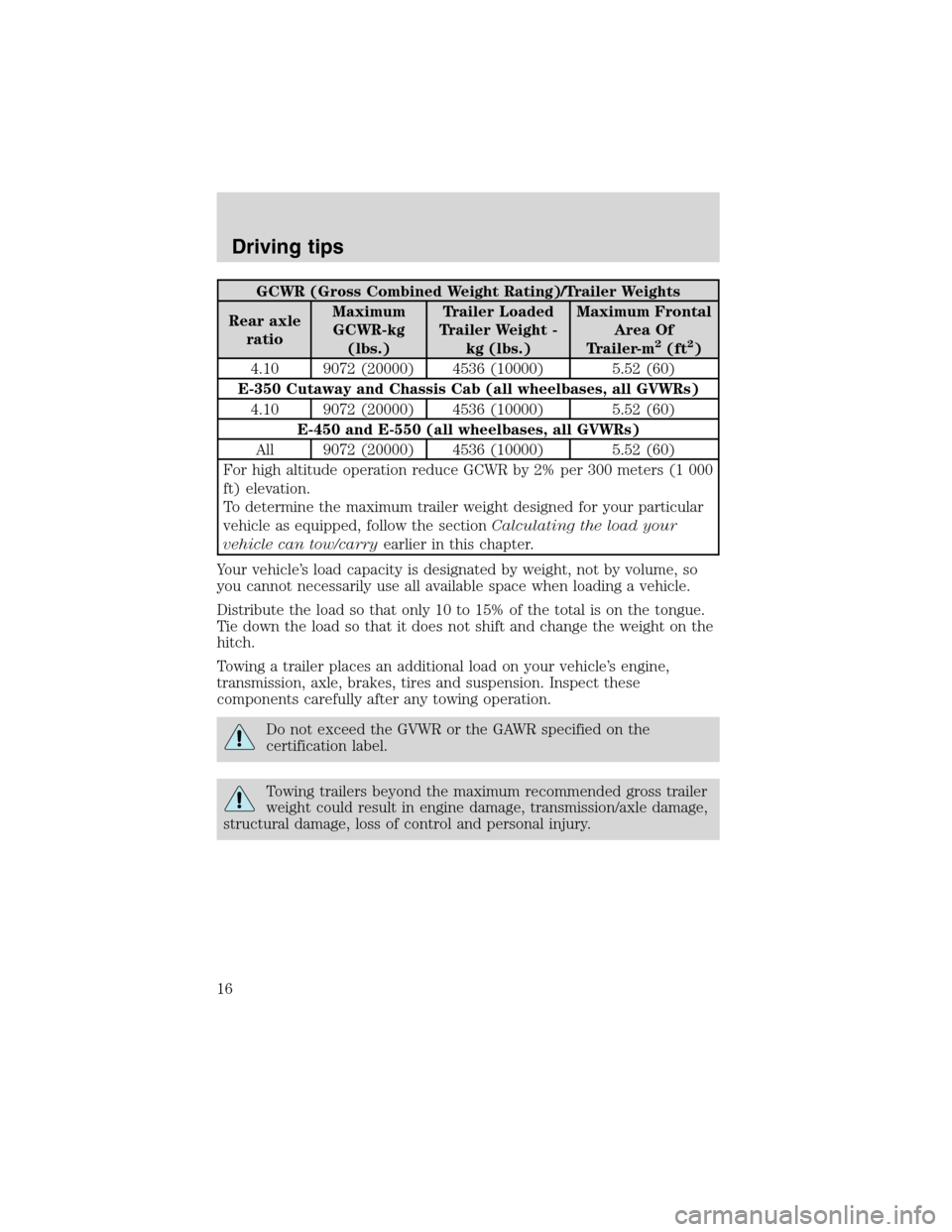
GCWR (Gross Combined Weight Rating)/Trailer Weights
Rear axle
ratioMaximum
GCWR-kg
(lbs.)Trailer Loaded
Trailer Weight -
kg (lbs.)Maximum Frontal
Area Of
Trailer-m
2(ft2)
4.10 9072 (20000) 4536 (10000) 5.52 (60)
E-350 Cutaway and Chassis Cab (all wheelbases, all GVWRs)
4.10 9072 (20000) 4536 (10000) 5.52 (60)
E-450 and E-550 (all wheelbases, all GVWRs)
All 9072 (20000) 4536 (10000) 5.52 (60)
For high altitude operation reduce GCWR by 2% per 300 meters (1 000
ft) elevation.
To determine the maximum trailer weight designed for your particular
vehicle as equipped, follow the sectionCalculating the load your
vehicle can tow/carryearlier in this chapter.
Your vehicle’s load capacity is designated by weight, not by volume, so
you cannot necessarily use all available space when loading a vehicle.
Distribute the load so that only 10 to 15% of the total is on the tongue.
Tie down the load so that it does not shift and change the weight on the
hitch.
Towing a trailer places an additional load on your vehicle’s engine,
transmission, axle, brakes, tires and suspension. Inspect these
components carefully after any towing operation.
Do not exceed the GVWR or the GAWR specified on the
certification label.
Towing trailers beyond the maximum recommended gross trailer
weight could result in engine damage, transmission/axle damage,
structural damage, loss of control and personal injury.
Driving tips
16